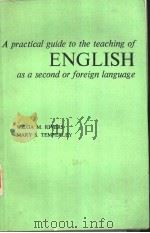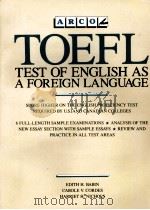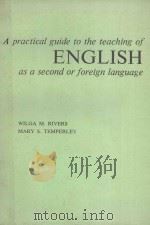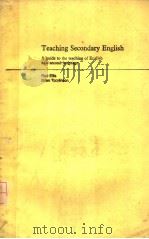《Teaching English as a Foreign Language》
| 作者 | 编者 |
|---|---|
| 出版 | Macmillan & Co. Ltd. |
| 参考页数 | 124 |
| 出版时间 | 1957(求助前请核对) 目录预览 |
| ISBN号 | 无 — 求助条款 |
| PDF编号 | 811985028(仅供预览,未存储实际文件) |
| 求助格式 | 扫描PDF(若分多册发行,每次仅能受理1册) |

Ⅰ.AIMS OF THE ENGLISH LANGUAGE COURSE1
A.BASES OF AIMS1
1.General Educational Bases1
2.Linguistic Bases3
(a)English as Speech3
(b)Correctness and Drift5
(c)Active-Passive Divergences7
3.Cultural Bases8
(a)Nature of Cultural Content8
(b)Dangers in Cultural Bias9
B.DIVERGENCES BETWEEN AIMS AND METHODS10
C.FRAMING OF AIMS11
1.Over-all Aims13
2.Major Aims13
(a)Major Functional Aims13
(b)Major Cultural Aims14
3.Specific Aims14
(a)Chiefly Oral(Aural-Oral)Activities15
(b)Chiefly Reading Activities15
(c)Chiefly Writing Activities16
Ⅱ.SURVEY OF PRINCIPLES AND METHODS17
A.GRAMMAR-TRANSLATION METHOD17
B.NATURAL METHOD18
C.PSYCHOLOGICAL METHOD19
D.REFORM OR PHONETIC METHOD21
E.DIRECT METHOD21
F.ORAL METHOD OR APPROACH27
G.READING METHOD28
1.Exclusion of Oral Reading Criticised29
2.Method of Comparing Cognates Inapplicable30
H.ECLECTIC OR COMPROMISE METHOD30
I.CONCLUSION31
Ⅲ.PSYCHOLOGICAL PROBLEMS—Ⅰ32
A.UNCONSCIOUS AND CONSCIOUS ASSIMILATION32
B.INDUCTIVE AND DEDUCTIVE METHODS34
C.THINKING IN A LANGUAGE37
1.Relation between Thought and Speech37
2.Intervention of the Mother Tongue39
3.Psychosemantic Approach42
D.TRANSLATION AND TRANSLITERATION43
Ⅳ.PSYCHOLOGICAL PROBLEMS—Ⅱ48
A.TRANSFER OF TRAINING48
B.GRADATION AND SIMPLIFICATION50
1.Object of Scientific Gradation50
(a)Motivation50
(1)Promotion of Learning Readiness50
(2)Sense of Achievement51
(b)Learning English as Speech52
2.Gradation of Linguistic Material52
(a)Scientific and Unscientific Gradation52
(b)Vocabulary Control and Collocations53
(c)Structural Types and Patterns56
(d)Other Elements57
3.Gradation of Cultural Content58
(a)Simplified Material in the English Curriculum58
(b)Pitfalls in Simplification60
(c)Basic English60
Ⅴ.PHONETICS AND TONETICS—PRINCIPLES IN THE LIGHT OF TEACHING62
A.CRITERIA OF PRONUNCIATION TO BE TAUGHT62
1.Criteria of an'Ideal'Pronunciation62
2.Criteria of Comprehensibility64
B.PURPOSE AND DELIMITATION OF PHONETIC NOTATION65
1.Narrow Notation65
2.Broad and Phonemic Notation67
C.COMPARATIVE VALUES OF VARIOUS SYSTEMS OF NOTATION69
1.Systems Employing Ordinary Letters of the Alphabet69
2.Phonemic Systems Designed for Teaching English as a Foreign Language71
3.Comparative Diagram of Narrow,Broad,and Simplified International Phonetic Notation72
D.TONETIC NOTATION76
Ⅵ.PHONETICS AND TONETICS—IN ACTION;AND THE TEACHING OF VOCABULARY78
A.HOW TO PREPARE AND USE PHONETIC SYMBOLS,DIAGRAMS,AND DRAWINGS IN TEACHING78
B.STRESS MARKS AND TONETIC DEVICES79
1.Methods of Marking Stress79
2.Methods of Marking Intonation80
C.SPECIAL EXERCISES FOR TEACHING PRONUNCIATION AND INTONATION80
1.Exercises for Teaching Phonemic Distinctions80
2.Exercises for Teaching Tonetic Distinctions81
3.Exercises for Teaching Word-linking and Juxtaposition81
4.Exercises for Teaching the Weak Forms and Contractions83
5.Exercises Involving Nonsense Sound Combinations85
6.Exercises Involving the Obscure Vowel85
D.MORPHOLOGICAL AND SEMANTIC UNITS86
E.TEACHING WORDS IN CONTEXTS AND SITUATIONS86
Ⅶ.STRUCTURAL AND IDIOMATIC IN ACTION92
A.FROM STRUCTURAL TO IDIOMATIC92
1.Homo-Syntactical Question-Answer Work93
2.Homo-hetero-Syntactical Question-Answer Work95
3.Hetero-Syntactical Question-Answer Work96
B.FUNCTIONAL STUDY OF CLAUSES AND PHRASES97
C.COMPLETION EXERCISES AT THE HIGHER LEVEL99
D.CONVERSION AND OTHER EXERCISES AT THE HIGHER LEVEL99
1.Direct to Indirect and Vice Versa100
2.Condensation and Expansion102
3.Paraphrasing102
E.INTENSIVE AND EXTENSIVE READING102
F.METHODS OF CALLING ATTENTION TO LITERARY DEVICES103
G.GAMES AND GAME-LIKE ACTIVITIES104
Ⅷ.ORGANISATIONAL PROBLEMS,AND RETROSPECT AND PROSPECT106
A.ORGANISATIONAL PROBLEMS106
1.Organisation of the Course106
2.Organisation of the Class108
B.RETROSPECT110
1.What to Evaluate110
2.When to Evaluate110
3.How to Evaluate111
4.Meaning of Grades114
5.Validity and Reliability116
C.PROSPECT118
1.Use of Questionnaires118
2.Function of Study Groups and English Teachers'Associations119
3.Toward Articulating the Various Levels of Learning120
SELECTED BIBLIOGRAPHY122
1957《Teaching English as a Foreign Language》由于是年代较久的资料都绝版了,几乎不可能购买到实物。如果大家为了学习确实需要,可向博主求助其电子版PDF文件(由 1957 Macmillan & Co. Ltd. 出版的版本) 。对合法合规的求助,我会当即受理并将下载地址发送给你。
高度相关资料
-
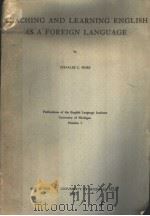
- TEACHING AND LEARNING ENGLISH AS A FOREIGN LANGUAGE
- 1947 ANN ARBOR UNIVERSITY OF MICHIGAN PRESS
-
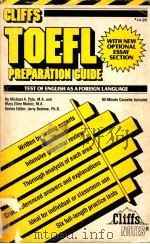
- TEST OF ENGLISH AS A FOREIGN LANGUAGE PREPARATION GUIDE
- 1986 CLIFFS NOTES
-

- THE PLACE OF LITERATURE IN THE TEACHING OF ENGLISH AS A SECOND OR FOREIGN LANGUAGE
- 1978 THE EAST-WEST CULTURE LEARNING INSTITUTE
-
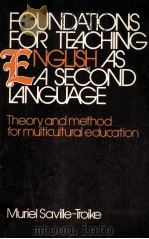
- Foundations for teaching English as a second language
- 1976 Prentice-Hall
-

- English as a Second and Foreign Language
- 1973 Edward Arnold
-

- LONGMAN EXAM GUIDES ENGLISH AS A FOREIGN LANGUAGE
- 1986 LONGMAN
-
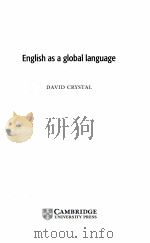
- ENGLISH AS A GLOBAL LANGUAGE
- 1997 CAMBRIDGE UNIVERSITY PRESS
-
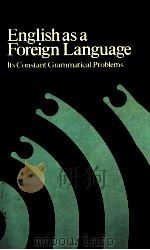
- ENGLISH AS A FOREIGN LANGUAGE THIRD EDITION
- 1981 GEORGE ALLEN & UNWIN
-

- MMC: DEVELOPING COMMUNICATIVE COMPETENCE IN ENGLISH AS A FOREIGN LANGUAGE
- 1974 UNIVERSITY OF PITTSBURGH PRESS
-
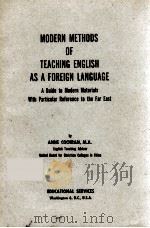
- MODERN METHODS OF TEACHING ENGLISH AS A FOREIGN LANGUAGE
- 1952 EDUCATIONAL SERVICES
提示:百度云已更名为百度网盘(百度盘),天翼云盘、微盘下载地址……暂未提供。➥ PDF文字可复制化或转WORD
